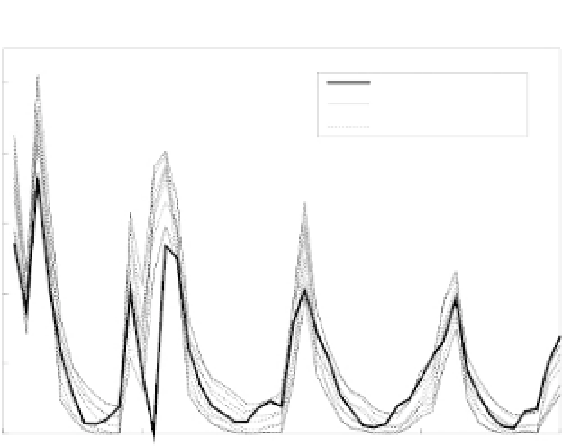Geology Reference
In-Depth Information
1.0e + 08
Observed
Simulated bounds
Simulated
8.0e + 07
6.0e + 07
Fig. 14.3
Example comparison
of observed discharge record
with output uncertainty
bounds created from a series
of individual simulations: the
Agri basin in southern Italy.
Reproduced from Bathurst
et al
.
(2002) by permission of John
Wiley and Sons.
4.0e + 07
2.0e + 07
0.0e + 00
0
12
24
36
48
Time (months)
simulations, create corresponding bounds on the
model output (Ewen & Parkin, 1996; Lukey
et al
.,
2000; Bathurst
et al
., 2004) (Fig. 14.3). The model
parameters or functions to which the simulation
results are typically most sensitive in full basin
simulations are: saturated zone hydraulic con-
ductivity, overland flow resistance coefficient,
soil hydraulic property curves (the variations of
moisture tension and hydraulic conductivity
with moisture content), the relationship between
the ratio of actual to potential evapotranspiration
and soil moisture content, root cohesion and the
soil erodibility coefficients.
With the introduction of uncertainty enve-
lopes, the aim of the calibration is then not to
reproduce the observed hydrological and sedi-
ment yield responses as accurately as possible
with one simulation, but to bracket the observed
responses with several simulations. Between
them, these simulations should represent the
uncertainty in the key inputs.
Finally, the traditional calibration of models
against outlet water and sediment discharges
concerns only the integrated basin response and
does not test for internal basin response. A good
outlet simulation could be obtained on the basis
of compensating internal errors (e.g. Anderton
et al
., 2002). Spatially-distributed models cannot
therefore be considered to be fully calibrated
unless they are shown to be able to reproduce
internal as well as outlet responses. Incorpo-
ration of internal data can also help to constrain
parameter uncertainty (e.g. Franks
et al
., 1998;
Christiaens & Feyen, 2002; Blazkova
et al
., 2002;
Ebel & Loague, 2006).
14.5
Model Fitness for Purpose
Validation tests the applicability of the calibrated
model. However, Ewen and Parkin (1996) have
criticized standard techniques of model validation
for not clearly testing a model's fitness for purpose.
The particular purpose of interest here is predict-
ing the impacts of future changes in land use and
climate. In this case, the prediction essentially
concerns a hypothetical basin which will exist (if
at all) only after the specified changes take place
(Ewen & Parkin, 1996). Model validation should
therefore involve the test basin as if it were hypo-
thetical. The modeller should not be allowed sight
of measured output data for the basin and thus
should not be able to calibrate the model for that
basin (hence the term 'blind' testing). Ewen and
Parkin (1996) consequently proposed a blind test-
ing procedure in which output uncertainty bounds




























